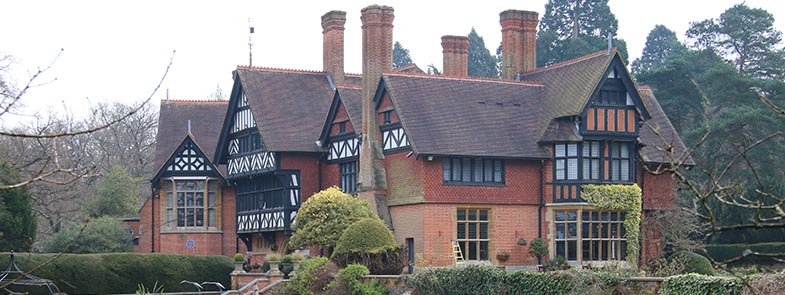Like any country house and estate in England, Grim’s Dyke has had its fair share of changes over the years. Originally designed and built in 1870’s by Richard Norman Shaw, Grim’s Dyke has had name and owner changes, conversions and additions to its original layout – but the biggest of those changes happened at the start of World War I.
World War I
With the outbreak of war, staffing numbers for country houses and estates dropped significantly, as unfortunately, also did the number of heirs returning from the war. The military was in need of land and buildings, for training, rehabilitation and hospitals – and the country estate homes were the obvious choices.
Homes seldom had central heating, so expensive wood panels, antique furniture and carved staircases were often used for firewood. After the War, homes were often returned in an incredibly poor state to their original owners. This in part, led to the massive decline in country estates, as many were demolished or auctioned off.
Grim’s Dyke luckily seemed to have escaped this fate, as Lady Gilbert was in residence there until her death in 1936.
Rehabilitation Centre
After Lady Gilbert’s death, Grim’s Dyke was jointly bought at auction by London and Middlesex Country Councils. It was then leased to North West Hospital Board, who used it as a rehabilitation centre for women suffering from Tuberculosis for the next two years.
World War II
With the outbreak of the second world war, Grim’s Dyke, like many other estates, was again, used by the military. There has been talk of it being used for secret projects during this time, allegedly including a secret extension of the Enigma programme. Alas, the use of any estates and homes during WWII will not be declassified until the 2040’s, so confirmation of these rumours will be some way off.
After the war
Once war was over, Grim’s Dyke was again used as a rehabilitation centre for Tuberculosis – briefly for both men and women (1945 – 1948), before becoming a male only centre from 1948 – 1963.
Like many of the surviving estates, Grim’s Dyke then fell into a state of decline. However, thanks to its location and visual appeal, it survived for several years as a film and TV set, before being converted to a hotel and country club in 1970.
The present owners took over and an extensive renovation and restoration project was completed on the Grade II listed building in 1996, bringing the hotel up to its 4-star standard.
Grim’s Dyke has had a colourful history, some of which is yet to be declassified. Thankfully though, it’s stood the test of time, thanks in part, to the visions of both architect Norman Shaw and W.S. Gilbert. They both excelled in their own specific niches, but in doing so, have helped ensure Grim’s Dyke didn’t befall the fate of so many country estates of that era.


